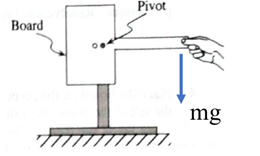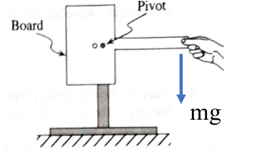
A T-shaped board of uniform mass density has two small holes as shown. Initially, the pivot is placedthrough the right hole, which corresponds to the center of mass of the board. The board ¡s then held in place.
1. Predict the motion of the board after it is released from rest, Explain.

2. Check your prediction by observing the demonstration.
a. Describe the
What does your answer imply about the ne, torque about the pivot? Explain.
b. Describe the acceleration of the center of mass of the board. Explain how you can tell.
What does your answer imply about the net force acting on the board? Explain.
3. Explain how your answers about net torque and net force in question 2 would change, if at all, if there is appreciable friction between the board and the pivot and the board remains at rest.
(1)
To Predict: The motion of the board.
Answer to Problem 1aT
The board will perform a circular repetitive motion.
Explanation of Solution
Given:
Gravitational force is acting downward on the edge of the handle.

Formula used:
Calculation:
Conclusion:
The gravitational force at the edge of the handle leads to produce torque using equation in formula. r is the distance between the edge of the handle and the pivot around which the board will rotate. Angle between r and force is 90 degree.
(2)
To Describe: The angular acceleration of the board, acceleration of the center of mass and the net torque about the pivot.
Explanation of Solution
Given:

Formula used:
Where, I is the moment of inertia and
Calculation:
From part 1, the net torque is
From the rotational equation of motion:
On comparing both the equations:
The center of mass of the board lies on the axis of rotation, therefore, the acceleration of the center of mass is zero.
The net torque is
Conclusion:
Hence, the angular acceleration is
(3)
The effect of friction on the torque and force.
Answer to Problem 1aT
The net torque and force will be reduced due to friction in effect.
Explanation of Solution
Given:
Gravitational force is acting downward on the edge of the handle.
Formula used:
Calculation:
Conclusion:
The frictional force acts opposite to the motion of the object. Hence, net force and torque are reduced which eventually reduces the angular acceleration and linear acceleration.
Want to see more full solutions like this?
Chapter 4 Solutions
Tutorials in Introductory Physics
Additional Science Textbook Solutions
College Physics
Essential University Physics: Volume 1 (3rd Edition)
University Physics Volume 2
Conceptual Physical Science (6th Edition)
The Cosmic Perspective Fundamentals (2nd Edition)
Life in the Universe (4th Edition)
- The angular acceleration of a rotating rigid body is given by =(2.0-3.0t)rad/s2 . If the body starts rotating from rest at t=0 , (a) what is the angular velocity? (b) Angular position? (c) What angle does it rotate through in 10 s? (d) Where does the vector perpendicular to the axis of rotation indicating 0 at t=0 lie at t=10s ?arrow_forwardLet there be a disk shaped merry-go-round of radius R = 2m and mass M = 90 kg with a 30 kg child riding on at the outer edge. It spins at a rate of 2 revolutions per second with %3D the child on it. a. What is the initial angular velocity? b. If the child falls off, what is the new angular velocity? (hint use conservation of angular momentum)arrow_forwardA thin light string is wrapped around the outer rim of a uniform hollow cylinder of mass 4.75 kgkg having inner and outer radii as shown in the figure (Figure 1). The cylinder is then released from rest. a.) How far must the cylinder fall before its center is moving at 6.78 m/sm/s? Express your answer in meters. b.) If you just dropped this cylinder without any string, how fast would its center be moving when it had fallen the distance in part A? Express your answer in meters per second.arrow_forward
- A barbell consists of a 0.50 kg ball and 2.00 kg ball connected at their centers by a masslessthreaded rod of length 0.50 m. To receive full credit, include with your correct solution an annotatedsketch of the situation.a. Where is the center of mass of the barbell?b. What is the linear speed of each ball if the barbell rotates about its center of mass at 40.0 rpm?arrow_forwardPlease solve all i know Bartelby rules but solve all questions. Qno1 . A sanding disk with rotational inertia 9.0x 103 kg-m is attached to an electric drill whose motor delivers a torque of magnitude 43 N-m about the central axis of the disk. About that axis and with torque applied for 52 ms, what is the magnitude of the (a) angular momentum and (b) angular velocity of the disk? a) numbers (?) Units (?) b) numbers (?) Units(?) 2) A wheel starts from rest and has an angular acceleration that is given by a (t)-6 rad/s) The angle through which it turns in time t is given by: a) ((1/8)trad/s⁴ b) ([1/4]r" rad/s⁴ c) ((1/2)trad/s⁴ d) ((t") rad/s² c) 12rad 3) A disk, initially rotating at 144 rad/s, is slowed down with a constant angular acceleration of magnitude 3.75 rad/s². (a) How much time does the disk take to stop? (b) Through what angle (rad) does the disk rotate during that time? a) numbers(?) Units(?) b) numbers (?) Unjts(?) 4) Ameter stick balances horizontally on a knife-…arrow_forwardTwo blocks of wood (1 kg each) are connected with a 1m long rope. Another 1m long rope is tied to one of the blocks and connected to a rotating axle. The ropes can only hold 100N of tension before breaking. (Assume the ropes have no mass). !a. Derive equations for the tension in the ropes as a function of angular velocity.b. At what angular velocity will the rope break? c. Which rope breaks first?arrow_forward
- A bullet of mass m fired from a cannon located at the origin. The shell moves i yz plane, where z is the vertical coordinate, with an initial velocity of magit at an angle 0 above the y axis. a. What is the torque on the shell, about the origin, as a function of time? b. What is the angular momentum of the shell about the origin as a fun time? (Use the definition of L). c. Verify that 7 = dlarrow_forwardOnly do parts D and E please. A carousel with a radius of R = 3.0 meters is initially at rest. It is then given a constant angular acceleration ? = 0.6 rad/s2 . A. Sketch the physical situation and label your sketch with appropriate quantities from the problem statement. Make a table of known/given information and unknown/wanted information (this may involve reading the rest of the problem before starting). List any physical assumptions you will be making to solve the problem. B. What is the angular velocity of the carousel after t = 8 s? What is the linear velocity of a child located at 2.5 meters from the center of the carousel after t = 8.0 s? What is the tangential acceleration of the child at that time? What is the child’s radial acceleration at that time? C. Determine the magnitude and direction of the child’s total acceleration vector after 8 seconds. Add this vector to your diagram above and show the directions of the radial and tangential components. D. How many rotations…arrow_forwardA ship's wheel can be approximated as an annular cylinder (different from a ring) of mass 6.7 kilograms, inner radius 25 centimeters, and outer radius 32 centimeters; and eight spokes of mass 0.50 kilograms and length 49 centimeters. a. What is the moment of inertia? Include units in your answer. More information. b. Disagreeing over which way to go, the captain and the helmsman try to turn the wheel in opposite directions. The captain applies a force of 311 newtons at the inner radius, while the helmsman applies a force of 287 newtons at the outer radius. What is the magnitude of the angular acceleration of the wheel? Include units in your answer. PLEASE RESPOND IN HANDWRITINGarrow_forward
- A ship's wheel can be approximated as an annular cylinder (different from a ring) of mass 6.7 kilograms, inner radius 25 centimeters, and outer radius 32 centimeters; and eight spokes of mass 0.50 kilograms and length 49 centimeters. a. What is the moment of inertia? Include units in your answer. More information. b. Disagreeing over which way to go, the captain and the helmsman try to turn the wheel in opposite directions. The captain applies a force of 311 newtons at the inner radius, while the helmsman applies a force of 287 newtons at the outer radius. What is the magnitude of the angular acceleration of the wheel? Include units in your answer.arrow_forwardA stone is suspended from the free end of a wire that is wrapped around the outer rim of a pulley, similar to what is shown in (Figure 1). The pulley is a uniform disk with mass 11.0 kgkg and radius 35.0 cmcm and turns on frictionless bearings. You measure that the stone travels a distance 12.4 mmduring a time interval of 4.00 ss starting from rest. A.Find the mass of the stone. Express your answer with the appropriate units. B.Find the tension in the wire. Express your answer with the appropriate units PLEASEEEEE ANSWER ALLarrow_forwardActionspulley which can be moduled as a 0.32 kg sold cylinder with a 0.31 maus, has a repe going over d as shown in Part A The sions the pe are 12 N and 10 N. What is the angular acceleration of the pulley? Express your answer in radians per second equared to two significant figures. 1. Submit ATA ? rel/ 12 N Review Constants Periodic Tab 10 N Next>arrow_forward
 University Physics Volume 1PhysicsISBN:9781938168277Author:William Moebs, Samuel J. Ling, Jeff SannyPublisher:OpenStax - Rice University
University Physics Volume 1PhysicsISBN:9781938168277Author:William Moebs, Samuel J. Ling, Jeff SannyPublisher:OpenStax - Rice University
